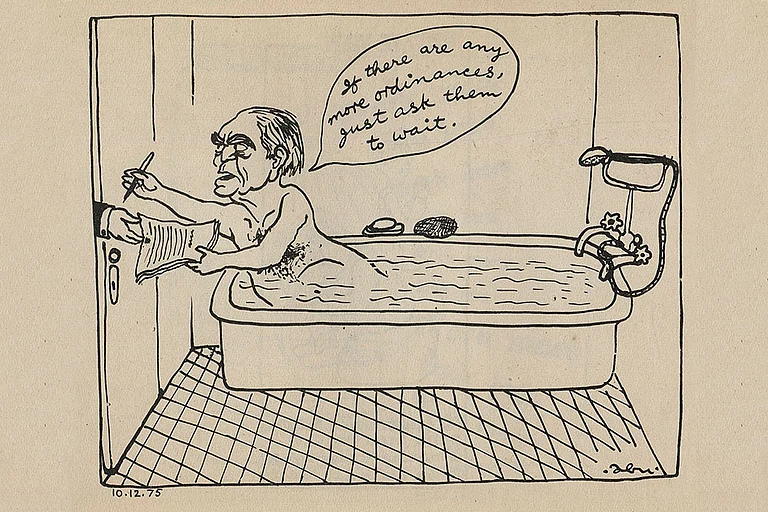On June 25, 1975, late in the night, India’s then-Home Minister Kasu Brahmananda Reddy meet with then-Prime Minister Indira Gandhi at her official residence. Reddy penned down the details of an earlier meeting with the PM and then President Fakhruddin Ali Ahmed. Reddy attached a draft proclamation, which Ahmed signed. By midnight, India was officially in a state of Emergency. Less than an hour to begin a 21-months period in history that the country may never forget.
50 Years After Emergency: Lessons And Consequences
June 25, 2025 would be the 50th anniversary of the 1975 State Emergency declared by then-Prime Minister Indira Gandhi
In the 21 months that India was under Emergency in 1975-76, the government ordered incarceration of opposition politicians, journalists, and activists. The Maintenance of Internal Security Act (MISA) was enforced and allowed for incarceration without trial. Forced sterilisation and squashing of dissent are some of the horror stories from that period. But some parts of India were more hard hit than others. Andhra Pradesh was one such place.
On June 22, 1975, Gandhi, through her personal secretary RK Dhawan, summoned then-Andhra Pradesh Chief Minister J. Vengal Rao.
AP saw 1135 detainees under MISA, 45 under the Conservation of Foreign Exchange and Prevention of Smuggling Activities Act (COFEPOSA), and 451 under the Defence and Internal Security of India Rules (DISIR), noted the Shah Commission, charged with investigating excesses during the Emergency.
The Commission's report showed that anyone not in with the Gandhi-government was against it and that this was not limited to politicians. Of the over 500 detainees, members of banned organisations (including 350 from the CPML), only 210 were political prisoners. The remaining were classified as “criminals” or “anti-social elements.”

Between 1975 and 1977, Indira Gandhi’s emergency rules cracked down on freedom of the press, and this included political cartoons. At the time, Gandhi instituted a pre-censorship system of newspapers—every article and cartoon had to be cleared before publication.
At the time, even revered cartoonists had a tough time publishing their works, or faced dire consequences. Renowned cartoonist Abu Abraham released several satirical illustrations speaking to the powers that be for the Indian Express. His work met with significant backlash from the government.

Speaking on the 50th anniversary of what is considered one of the darkest eras of Indian politics, on June 25, 2025, Prime Minister Narendra Modi said that this time was one where the then-ruling party, the Indian National Congress, Indira Gandhi’s party, put “democracy under arrest.” Calling the 1975 Emergency as a "prime example of their (Congress’s) shenanigans", Modi added that no Indian will forget how spirit of the Constitution was violated during that time.
However, Modi’s words come at a time when all opposition parties are united and calling his government’s 11-year-long rule as a “systematic and dangerous” assault on “Indian democracy” an “Undeclared Emergency.”
Jairam Ramesh, the Congress general secretary in-charge communications, has said that in the past 11 years, critics of the government have been vilified as anti-nationals, and that the ruling party has deliberately spread hate and bigotry among the populous.
In its October 1, 2024 issue Emergency The Legacy/The Lunacy, Outlook’s editor Chinki Sinha had alluded to the same issue—How different are the stories from those days of Emergency compared to the ones now?, she had asked.

Senior journalist Harish Khare had written on the lessons the Indian politico and citizens could stand to learn from the Emergency era. “No ruler can be granted a carte blanche, like it happened during the Emergency, but the fact remains that we also learnt some valuable lessons during this period,” he wrote, adding that “even after nearly 50 years, we are nowhere near any understanding of the nature of the breakdown of normal politics that led to that midnight denouement on June 25, 1975.”
Indian historian and novelist Mukul Kesavan wrote about growing up under the shadow of the Emergency. Indira Gandhi’s Gandhi’s principal legacy remains the systematic replacement of institutional governance with the vicious precedents of personalised rule, he wrote.
Former editor and political analyst R Balashankar recalls the midnight knock that so many Indians over the age of 65 remember as iconic to the Emergency period. “A large percentage of Indians who are below the age of 65 may not have witnessed the midnight knock that had doused the flame of democracy in India 49 years ago."
He added that "was the most draconian step taken by any prime minister who was shown to the office by the Constitution.”
